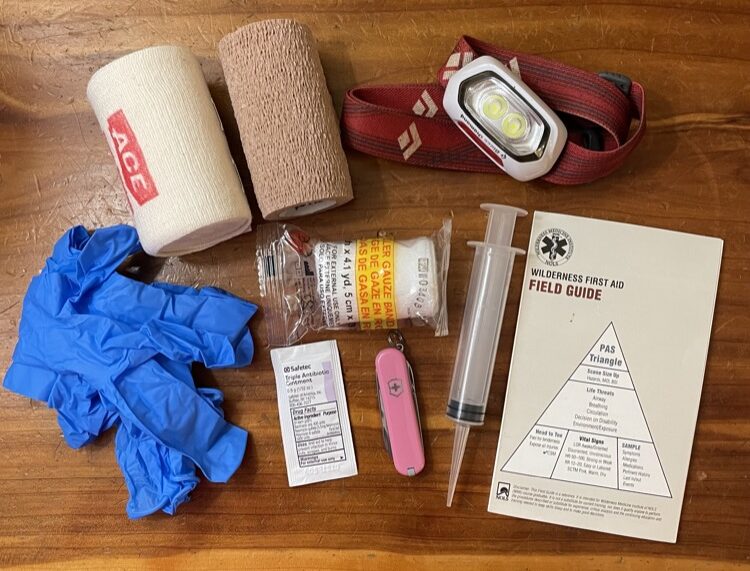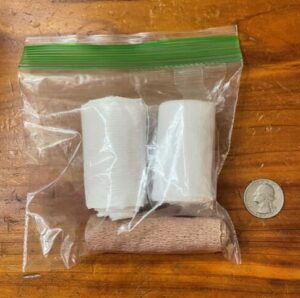This article was originally published in the March 2022 issue of UltraRunning Magazine. Subscribe today for similar features on ultra training, racing and more.
Q: What are the essential first aid or safety items I should always carry with me?
A: How much risk are you willing to accept when you go on a trail run? It’s a question worth thinking about because running down a trail is an inherently risky thing to do. You could fall, sprain your ankle, get lost, become hypothermic, get dehydrated, be struck by lightning, get bitten by a snake, get attacked by a dog, bear or Canada goose — potentially all on the same run.
The goal of this column is to identify the hazards you’re likely to face on the trails so you can best manage the risk, mitigate consequences and make good decisions about the places you want to run and race. Many of us tend to abdicate hazard assessment and risk management to race directors or more experienced running partners. Taking on this responsibility yourself will help you avoid uncomfortable, distressing and sometimes very dangerous situations.
We’ll start with falling hazards since bloody knees are part of the trail running initiation ceremony. The likelihood of falling increases the steeper and more technical the terrain gets, but we all know that hard falls can happen on flat, smooth-as-butter trails, too. Depending on what you land on and how far you fall, the consequences range from minor scrapes to severe trauma. While experience, stamina, trekking poles and mental focus can decrease the likelihood of falling, risk mitigation also depends, in large part, on managing the consequences. There are three important actions you can take to decrease the consequences of falling on a trail run for yourself and your friends:
- Take a Wilderness First Aid course.
- Keep a first aid kit in your car.
- Carry four first aid supplies in your hydration pack.
TAKE A WILDERNESS FIRST AID COURSE.
This course will teach you how to assess injuries and ailments in remote environments and make good decisions about treatment and evacuation. Everything in the 16-hour curriculum is applicable to trail running. You’ll leave the course better able to care for yourself and other trail runners. You’ll also gain a greater appreciation for the prevention and consequences of different injuries and environmental emergencies, which will allow you to assess and manage risk better. Perhaps most useful to falls, you’ll learn how to clean wounds effectively to promote rapid healing and prevent infection. The three largest and most established Wilderness Medicine programs are NOLS Wilderness Medicine, Wilderness Medical Associates and SOLO. REI hosts classes almost every month.
KEEP A FIRST AID KIT IN YOUR CAR.
The most common injury you’ll deal with after a fall is a bloody wound, so make sure your first aid kit has a roll of gauze and a roll of self-adhesive wrap in it. You can cut the gauze to size, and the self-adhesive wrap will keep it in place. Self-adhesive wrap is like an ACE bandage that sticks to itself. To prevent infection, add an irrigation syringe to the kit. Nothing cleans dirt out of a wound better than high pressure water from an irrigation syringe. Finally, make sure you have antibiotic ointment to keep the wound moist, which will speed healing. In addition to these items, your kit should contain gloves, a multi-tool with scissors, an ACE wrap, a headlamp and a first aid pocket guide.
Check to see if these items are in your car’s first aid kit:
SUPPLIES USAGE
| Roll of gauze | Can be cut to size |
| Self-adhesive wrap | To keep gauze in place, especially on knees, elbows and fingers |
| Irrigation syringe | To clean wound quickly and prevent infection |
| Antibiotic ointment | To keep wound moist and promote healing |
| ACE Wrap | For ankle support |
| Gloves | To prevent infection |
| Multi-tool with scissors | To cut the gauze |
| Headlamp | To see what you’re doing |
| First aid pocket guide | To aid decision-making |
CARRY FOUR FIRST AID SUPPLIES IN YOUR HYDRATION PACK.
 If you’re wearing a hydration pack, there’s no good reason not to put a roll of gauze and a 12-inch piece of self-adhesive wrap in it. These items weigh next to nothing, don’t take up space and will allow you to quickly care for a bleeding wound. Add a garbage bag in case the fall is bad enough that you need to wait for help. There’s nothing like a trash bag to keep you warm and dry. Finally, if your hydration pack doesn’t have a built-in whistle, get a thin plastic whistle so you can attract attention to yourself if you need help. Put these items in a snack-size Ziploc that will be at the bottom of your pack until you need them. Carrying more supplies makes sense the further your run will take you from your car and when cell service is limited, but the heavier and bulkier your first aid kit is, the less likely you are to take it with you. And if you don’t take it, it doesn’t matter what you have in it.
If you’re wearing a hydration pack, there’s no good reason not to put a roll of gauze and a 12-inch piece of self-adhesive wrap in it. These items weigh next to nothing, don’t take up space and will allow you to quickly care for a bleeding wound. Add a garbage bag in case the fall is bad enough that you need to wait for help. There’s nothing like a trash bag to keep you warm and dry. Finally, if your hydration pack doesn’t have a built-in whistle, get a thin plastic whistle so you can attract attention to yourself if you need help. Put these items in a snack-size Ziploc that will be at the bottom of your pack until you need them. Carrying more supplies makes sense the further your run will take you from your car and when cell service is limited, but the heavier and bulkier your first aid kit is, the less likely you are to take it with you. And if you don’t take it, it doesn’t matter what you have in it.
Falling is part of trail running, so being able to assess when someone is more likely to fall is important. Just as important is knowing how to manage the consequences of a fall. At the most basic level, risk management for falls involves having access to first aid supplies. Decreasing the likelihood of serious consequences also involves the ability to make good decisions about the extent of someone’s injuries after a fall. Many of the people who take Wilderness First Aid classes sign up after they’ve been unable to help someone who’s been involved in an accident. As trail runners with different comfort levels around risk and different experiences assessing it, one of the best steps we can take to better manage risk is to take a Wilderness First Aid course.

